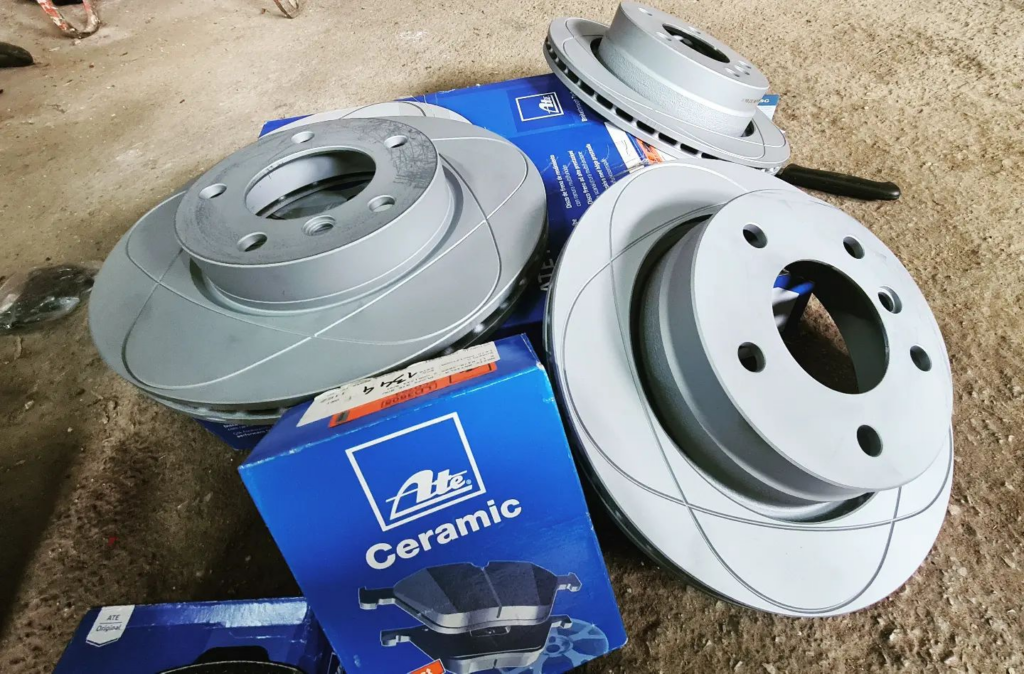When should you change brake discs? This essential safety question concerns every driver. If you’re hearing squeals during braking, feeling vibrations, or your car simply doesn’t stop as quickly as it should—a brake disc inspection is overdue. In the following sections, we’ll dissect these symptoms, delve into brake disc lifespans, and help you maintain peak brake performance, ensuring you know precisely when to change brake discs and why to consider replacement.
Key Takeaways
Brake discs are crucial for vehicle stopping power and come in various types such as flat, vented, waved edge, dimpled, drilled and slotted, combination, and carbon-ceramic, each suited for different vehicle needs and performance.
Brake disc wear can be caused by factors such as aggressive braking, frequent hard stops, resting the foot on the brake pedal, and environmental factors like moisture. Signs of wear include unusual noises, longer stopping distances, and vibration in the brake pedal.
Brake discs typically need to be replaced between 30,000 to 70,000 miles; however, signs such as squealing noises, vibrations, uneven wear, and visible damage indicate the need for earlier replacement. Regular inspections and proper driving habits can prolong their lifespan.
Understanding Brake Discs and Their Function
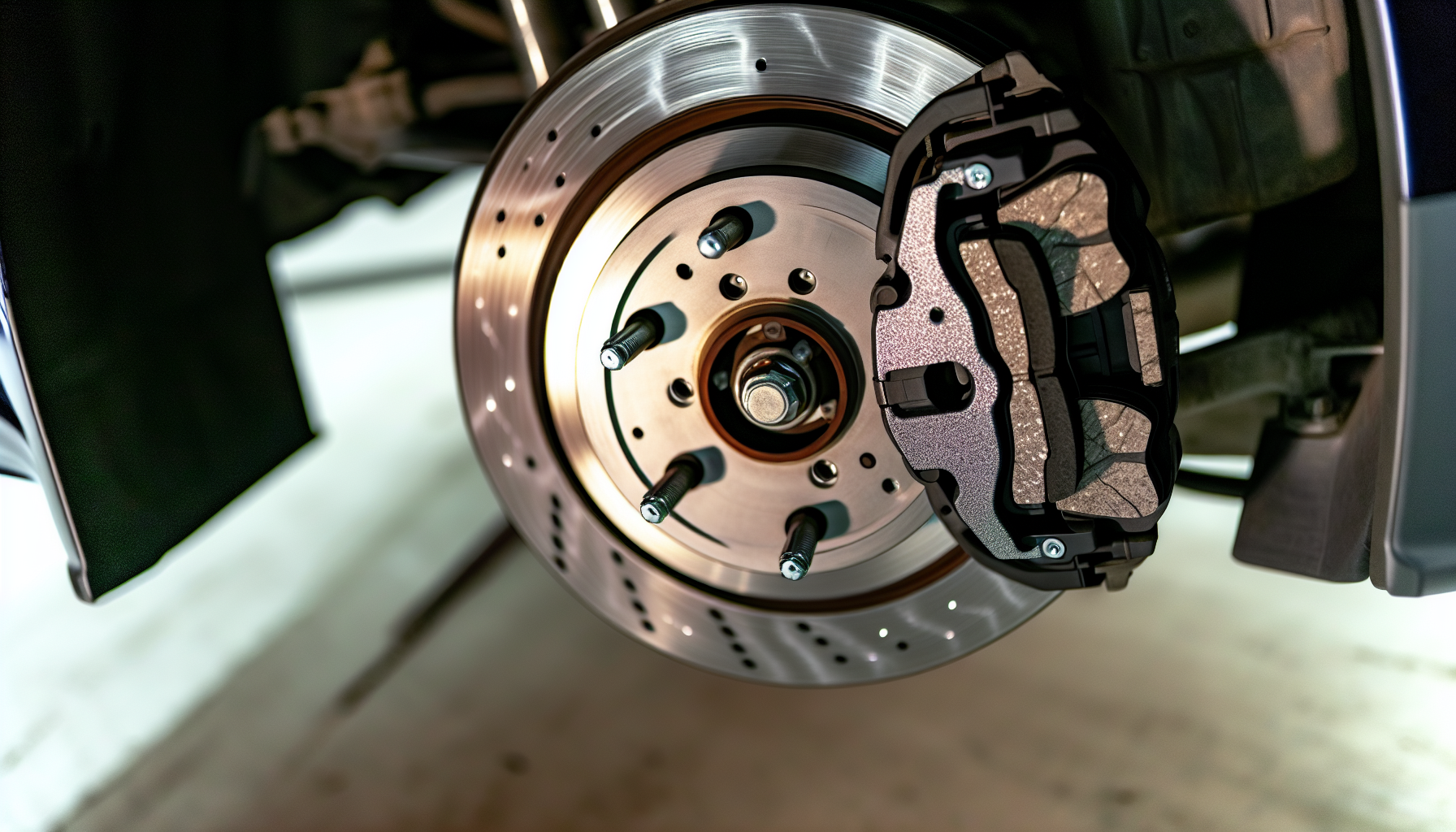
Brake discs are the heart of your vehicle’s braking system. When you press the brake pedal, your car’s brake pads clamp onto these discs, creating friction that slows your vehicle down. This process transforms kinetic energy into thermal energy, which is then efficiently dissipated into the atmosphere. It’s this process, taking place in the blink of an eye, that enables you to stop your car safely and precisely when you need to.
Given their pivotal role, you might be wondering: how do these brake discs function, and what variations exist?
How Brake Discs Work
The magic of brake discs unfolds when you press your brake pedal. This action sets off a chain of events:
Brake fluid is pushed through the brake lines
Brake calipers squeeze the brake pads against the brake discs
The resulting friction slows down your wheel, and in turn, your car
This braking process employs both adherent friction, with brake pad material being transferred between the pad and rotor, and abrasive friction, akin to the action of sandpaper on wood.
The composition of these brake pads significantly influences this process, fundamentally determining your car’s deceleration effectiveness. But not all brake discs are created equal. In fact, there are several types to consider.
Types of Brake Discs
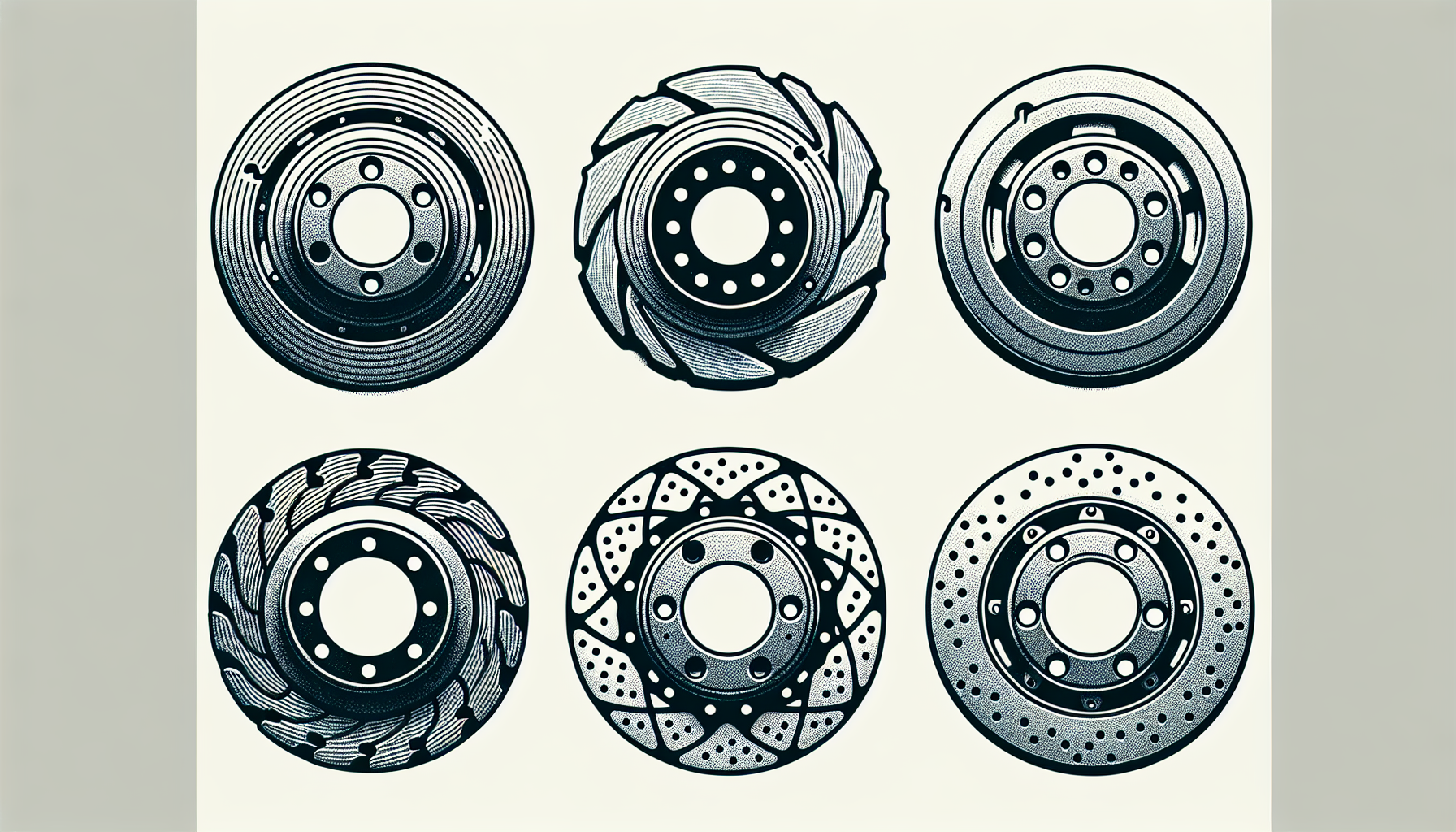
Brake discs, primarily made from cast iron, come in a variety of types, each tailored to specific performance needs. For instance, flat brake discs are a popular choice in smaller vehicles, offering good braking power thanks to their large surface area, while being lightweight and cost-effective. On the other hand, larger and heavier vehicles typically benefit from vented brake discs. This design features two discs with space in between for heat dissipation, making them ideal for vehicles that require more stopping power.
The variety of brake discs does not end here. We have:
Waved edge brake discs that disrupt airflow with their wavy design
Dimpled brake discs that balance weight reduction with heat resistance
Drilled and slotted brake discs that prevent pad glazing and reduce pulsation for better performance
Combination brake discs that incorporate slots and holes for optimal benefits
High-performance carbon-ceramic brake rotors that offer exponential cooling efficiency and lifespan
Identifying the appropriate brake disc for your vehicle is a step forward in guaranteeing optimal braking performance. However, similar to other vehicle parts, brake discs experience wear and tear. So, what causes this?
Common Causes of Brake Disc Wear
Brake disc wear is a common occurrence, and it can be accelerated by a variety of factors. Some factors that can contribute to brake disc wear include:
Frequent hard stops
Resting your foot on the brake pedal
Extreme stops when the rotors are cold
Extended exposure to moisture, which can cause rusting on your brake rotors.
What impact does this wear and tear have on your brake discs, and how can it be detected?
Aggressive Braking
Aggressive braking is a notorious culprit in brake disc wear. By frequently making hard stops, you can cause your brake rotors to warp, leading to a misconception that a wheel alignment is necessary. Furthermore, excessive heat transfer to brake discs and related components during aggressive braking hastens wear and could lead to brake fade, a condition where braking effectiveness is reduced.
Although hard braking may seem like a suitable response in certain situations, it’s advisable to avoid it to preserve your brake discs.
Environmental Factors
Environmental factors play a considerable role in brake disc wear. Moisture is a key player here. If your brake discs are exposed to moisture for prolonged periods, they can rust, leading to compromised braking performance. As a result, if you reside in an area with high humidity or regular rainfall, taking additional care of your brake discs is necessary.
Now that we understand the causes of brake disc wear, how can we recognize when it’s time to change them?
Top Signs It’s Time to Change Brake Discs
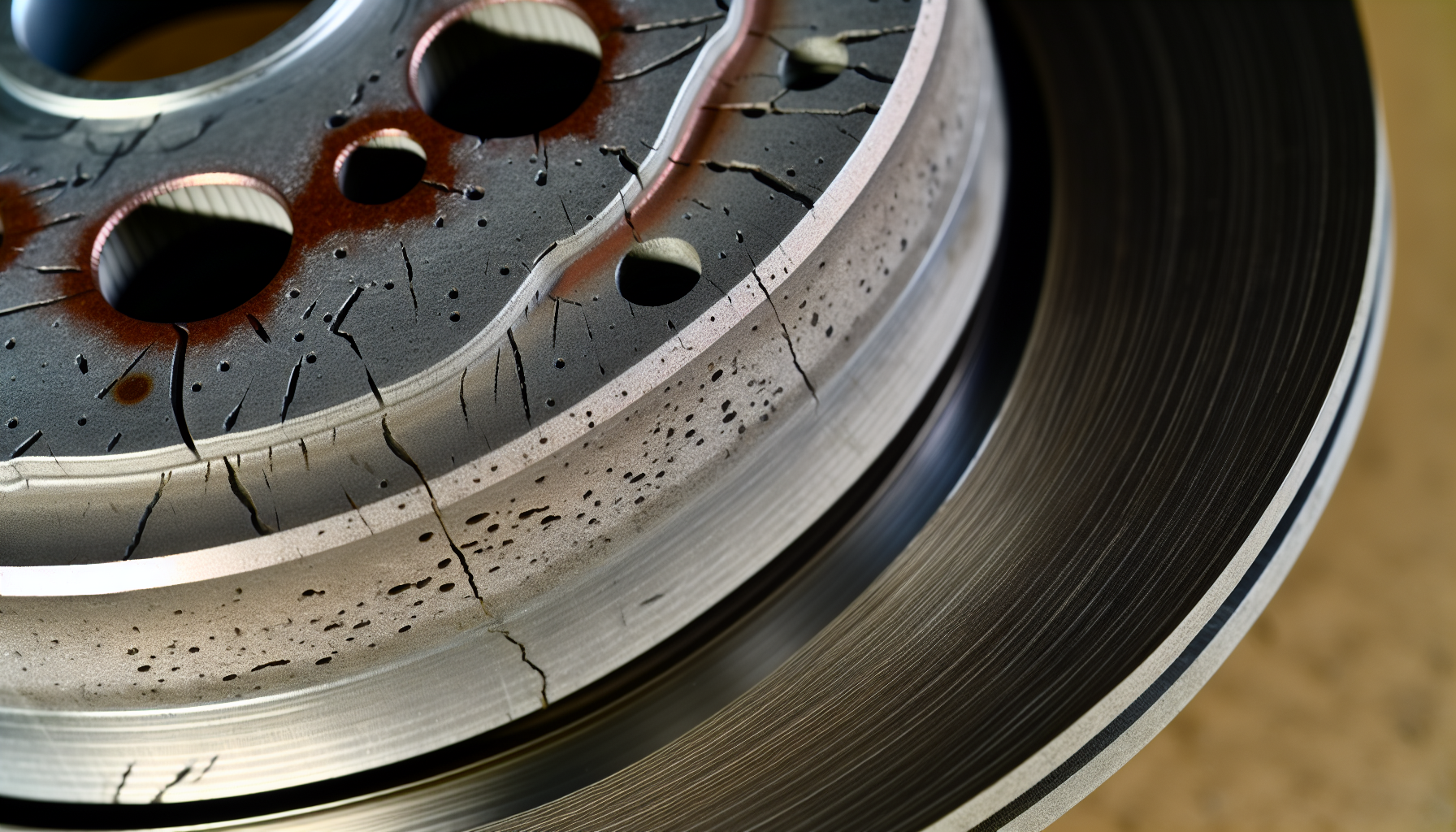
Recognizing when to change your brake discs is beneficial, and there are several indicative signs to be aware of. These include unusual noises, longer stopping distances, and a vibration or pulsating sensation in the brake pedal. If any of these signs appear, it’s probably time to inspect your brake discs more closely.
But what do these signs mean, exactly?
Unusual Noises
Your ears can be your best allies when it comes to detecting brake disc wear. Unusual noises, such as squealing, grinding, and the sound of metal on metal, often indicate that the brake discs may need to be examined and potentially replaced. For instance, a high-pitched screeching sound can be due to the wear indicators on the brake pads making contact with the brake disc, signaling that the pads are low.
A grinding noise, on the other hand, indicates a severe level of wear, where the brake pads are likely completely worn out, causing metal on metal contact and reducing braking effectiveness. These audible cues are crucial for identifying potential damage to your brake discs.
Longer Stopping Distances
If you’ve noticed that your vehicle is taking longer to stop than usual, this could be a sign of worn brake discs. Increased stopping distances suggest that your brake discs aren’t as effective as they should be, causing your vehicle to take longer to come to a halt. This is particularly dangerous under high-speed or emergency braking conditions, as it increases the risk of not stopping in time to avoid a collision. Therefore, extended stopping distances are a clear indicator of the need for brake disc replacement.
Vibration or Pulsating Brake Pedal
A pulsating or vibrating sensation in the brake pedal isn’t just uncomfortable—it’s also a sign of a potential problem with your brake discs. This sensation could mean the rotors are warped, which might also manifest as a shaking steering wheel. Brake vibrations can be caused by high spots on the rotor from glazing, uneven material deposits from brake pads, or hard braking leading to rotor warping.
If you notice any of these signs, it’s best to have your brake discs inspected as soon as possible. But how can you do this yourself?
Checking Your Brake Discs: A Visual Inspection Guide
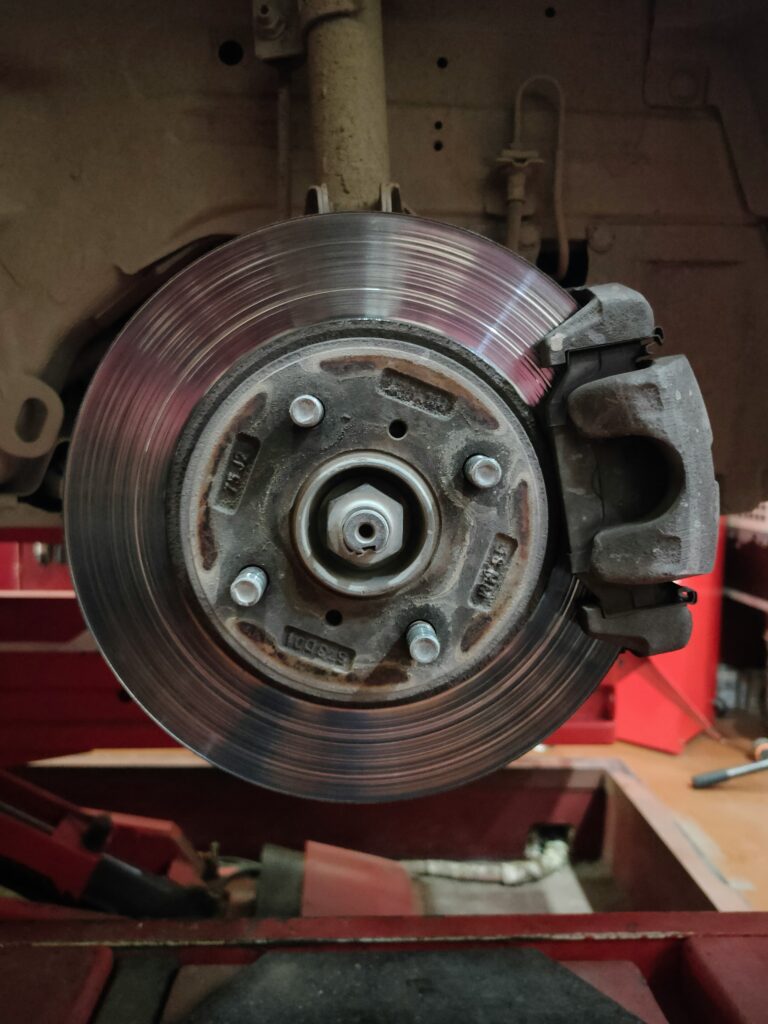
Visually inspecting your brake discs can assist in identifying signs of wear or potential damage. It’s important to ensure that the rotors are cool to the touch before you begin to prevent injury and ensure accurate results. By examining your brake discs for noticeable grooves, visible cracks, and heat spots, you can determine whether they need to be replaced.
Rust on the rotors is another key indicator to look out for, as this can compromise the rotor’s structural integrity and necessitate replacement. But where do you start?
Locating the Brake Discs
Locating the brake discs is the first step in inspecting them. Brake discs are located on the wheels of your vehicle and can only be accessed when your car is stationary. To begin the inspection process, you need to lift the vehicle using a jack, ensuring it’s situated on a flat, stable surface to prevent any movement. It’s crucial to support the vehicle securely with wheel blocks or jack stands to prevent it from falling. Adhering to these safety precautions allows you to locate your brake discs securely for examination.
Identifying Wear and Damage
Once you’ve located the brake discs, it’s time to identify any wear or damage on the brake rotor. Visible cracks on the brake rotors are serious indicators of damage and necessitate replace brake rotors. You can also check for noticeable grooves on the surface of the rotor by gently running a finger vertically down the rotor. If grooves are present, this signifies worn brake rotors that require replacement.
Signs of brake rotor wear include:
A lip on the edge of the rotor, indicating that it is worn down or wearing unevenly. You can use calipers for precise measurement.
Heat spots on the rotor. If the heat spots are extensive, the rotors will need to be replaced.
Rust on the rotors, particularly corrosive rust, which compromises the braking system’s integrity and necessitates rotor replacement.
Now that you know how to check your brake discs, the next question is, how often should they be replaced?
How Often Should Brake Discs Be Replaced?
The knowledge of when to change your brake discs is just as crucial as comprehending their functioning. Brake discs should typically be changed anywhere from 30,000 to 70,000 miles, with brake pads being replaced every 25,000 to 65,000 miles. However, these numbers can vary based on factors such as driving conditions and styles.
But how can these factors guide you in determining when to do brake discs replacement and when to replace your brake discs?
Mileage Recommendations
The mileage at which you should replace your brake discs largely depends on your driving conditions and style. While the range is typically between 30,000 and 70,000 miles, it’s important to take your unique driving habits into account. Measuring the brake disc thickness during routine maintenance can also help determine if they have reached the minimum thickness specification and require replacement. But it’s not just about mileage. There are other signs that indicate it’s time for replacement, such as:
Squeaking or squealing noises when applying the brakes
Vibrations or pulsations in the brake pedal
Longer stopping distances
Uneven wear on the brake discs
Visible cracks or damage to the discs
If you notice any of these signs, it’s important to have your brake discs inspected and replaced if necessary.
Signs It’s Time for Replacement
In addition to mileage, there are several signs that indicate it’s time to replace your brake pads. Worn brake pads with less than 25% of their friction material remaining should be replaced to ensure continued braking performance. If your brake discs display uneven wear or are badly scored, it’s advisable to replace them at the same time as you replace your brake pads to maintain optimal braking efficiency.
While standard steel brake rotors are engineered to last about 50,000-80,000 miles, carbon-ceramic brake rotors can last the entire lifetime of a car. So, once you’ve determined it’s time to replace your brake discs, should you do it yourself or seek professional help?
Brake Disc Replacement: Professional Service or DIY?
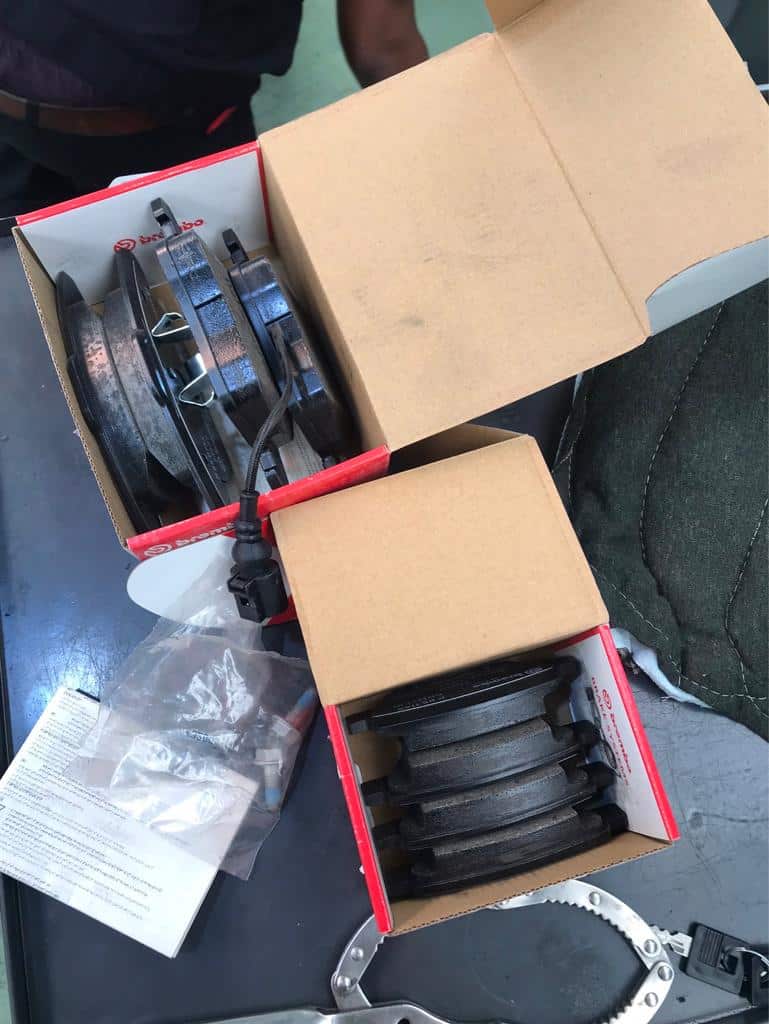
While the task of changing your brake discs may seem intimidating, the decision relies on your own skills and experience. If you’re proficient in car repairs and possess the required tools, performing a DIY brake job could be an economical solution. That being said, it’s crucial to know your limits, as the braking system is essential for vehicle safety.
On the other hand, professional mechanics provide labor warranties and are accountable for the repair quality. This offers peace of mind, knowing that any issues post-repair will be addressed. Keep in mind that incorrectly replacing brake discs can lead to serious safety risks, making professional services advisable for those who lack the necessary expertise.
If you decide to go the DIY route, there are a few tools and materials you’ll need.
Tools and Materials Needed
If you’re considering a DIY brake disc replacement, you’ll need to arm yourself with the right tools and materials. This includes:
A jack and jack stands to safely lift the vehicle
A socket wrench and ratchet set for removing the brake calipers
A torque wrench to apply the correct torque to caliper bolts and lug nuts
Depending on the type of bolts holding the brake calipers, you may also need an Allen/hex key set or torx set
And in case you need to disconnect the brake hose to change calipers, a brake line wrench, also known as a flare nut wrench, will come in handy.
Other tools you might need include a brake pad spreader or a c-clamp to reset the pistons for new brake pad insertion, and a brake piston caliper wind back cube tool for replacing new brake pads.
Safety Considerations
Safety is paramount when performing any car repair work, including brake disc replacement. It’s crucial to:
Wear gloves, a mask, and safety glasses for personal protection.
When lifting your vehicle, always support it with jack stands and never rely solely on a jack.
Loosen the wheel nuts before jacking up the vehicle to prevent it from rocking.
Avoid letting the brake caliper hang on the brake fluid hose and ensure it’s securely placed using a cable tie or string.
Use the correct tools for removing caliper pins, and avoid over-tightening to prevent damage.
Check and manage the brake fluid level regularly when pushing back the caliper pistons, removing excess as necessary to prevent overflow.
Now that we’ve covered brake disc replacement, let’s look at how to extend the life of your brake discs.
Tips for Extending the Life of Your Brake Discs
While it’s vital to comprehend when and how to replace your brake discs, learning how to prolong their lifespan is of equal significance. This can be achieved through proper driving habits and regular maintenance. By practicing gentle braking, anticipating stops, and maintaining your brake system regularly, you can prolong the life of your brake discs and ensure optimal braking performance.
But what do these practices entail in more detail?
Proper Driving Habits
Adopting proper driving habits is key to extending the life of your brake discs. This includes:
Using smoother braking techniques, which not only extend the life of brake discs but also improve vehicle safety
Controlled and stable braking helps prevent rotor warping
It can eliminate the need for frequent wheel alignments
By adhering to these habits and checking your brake discs regularly, you can minimize the overall wear and tear on your brake discs, thus ensuring their durability.
Regular Maintenance
Frequent maintenance is another essential element in lengthening the lifespan of your brake discs. Timely replacement of worn brake components prevents extensive and expensive repairs, ensuring small issues don’t become major problems. A well-maintained brake system can also maintain the vehicle’s resale value, as a proper maintenance history is valued by prospective buyers.
Staying on top of brake maintenance has several benefits:
Adheres to safety regulations and avoids potential legal issues or fines
Provides drivers with peace of mind, knowing their vehicle can stop safely in any situation
Ensures the longevity of brake discs
Brake system inspections are recommended every 10,000 to 12,000 miles or at least once a year to ensure safety and longevity of brake discs.
Lastly, investing in quality brake components from the start can lead to longer intervals between replacements and can extend the life of brake discs.
Summary
In summary, understanding your vehicle’s brake discs is crucial for ensuring optimal braking performance and safety on the road. By recognizing the signs of brake disc wear, carrying out regular inspections, and knowing when to replace them, you can extend the life of your brake discs and maintain your vehicle’s braking abilities. Whether you choose to replace your brake discs as a DIY project or opt for professional service, remember that regular maintenance and proper driving habits are key to prolonging the life of your brake discs. So, here’s to safe and efficient driving!
Frequently Asked Questions
How do you know when brake discs need replacing?
You should consider replacing brake discs when you notice noisy or squealing brakes, longer stopping distance, vibrations, or visible damage in your car. These signs indicate worn brake discs and the need for replacement.
How long do brake discs last?
Brake discs should generally last more than 50,000 miles on average, but with proper maintenance and sensible driving, you may be able to get up to 80,000 miles out of one set. Keep them well maintained for longevity.
Can you just change brake pads and not discs?
It’s not always necessary to replace brake discs when changing brake pads. The decision to replace the discs depends on their condition, and if they are warped or worn beyond repair, it’s recommended to replace them along with the brake pads.
How do I know when my disc rotors need replacing?
If you experience squealing sounds from the brakes, longer stopping time, or vibrations in the steering wheel when braking, it may be time to replace your disc rotors. Grooves, scratches, and a blue color on the rotors are also signs of potential replacement.
What is the role of brake discs in a vehicle’s braking system?
The brake discs play a crucial role in the braking system as they create friction with the brake pads, allowing the vehicle to slow down when the brake pedal is pressed.
